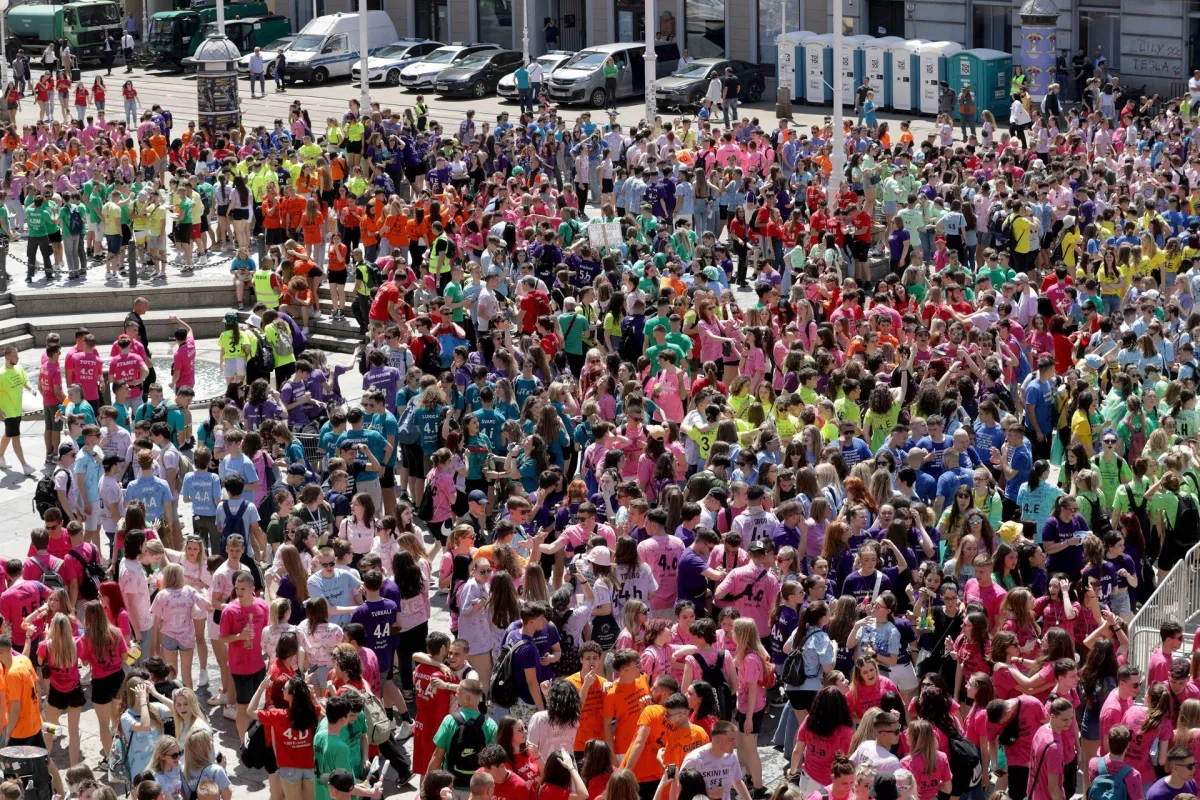
Why We Can’t Learn Croatian Without Learning Croatia: Norijada as a Rite of Passage
Inspired by the anthropological work of Milivoj Vodopija (1970s)

Photo: Boris Kovačev, Cropix
This May, like every May for over a century, the streets of Zagreb and other Croatian towns echo with shouting, singing, confetti, and laughter. Students in matching shirts spill into squares and block traffic. It seems chaotic, almost anarchic. But as Croatian ethnologist and sociologist Milivoj Vodopija observed in his foundational 1970s study, this event — norijada — is anything but random.
It is one of the few enduring, organically Croatian rites of passage, and understanding it tells us more about the Croatian soul than any textbook could.
A Folk Ritual in a Modern City
In his article, Vodopija does something quite radical for the time: he treats norijada not as a nuisance or a social curiosity, but as a legitimate anthropological ritual — a moment where social structures are symbolically inverted, where liminality is performed, and where the individual is transformed into something else.
He argues that what we see on the surface — dancing, yelling, mock-political slogans, silly outfits — is part of a deeply encoded cultural script. Norijada marks a transition: from pupil to citizen, from adolescent to adult, from one stage of social recognition to another. In his analysis, Vodopija aligns norijada with other European folk customs of seasonal inversion, carnival, and symbolic chaos.
The event serves a clear purpose: to ritualise the break between being under authority (teachers, parents, school rules) and entering a world of personal responsibility and autonomy. Just as in a traditional rite of passage, there is:
Separation – students leave school, often symbolised by the final school bell or the changing of clothes.
Liminality – the period of chaos, celebration, shouting, and anti-structure.
Reintegration – preparing for the matura exam and life as a new adult member of society.
Seen this way, norijada is not trivial. It is the most widespread and spontaneous modern Croatian ritual still actively practiced — and it has survived socialism, capitalism, war, and curriculum reform.

Photo: Damjan Tadić, Cropix
A Living Tradition With Local Colour
Vodopija was writing in the 1970s, but the structure he observed still holds today. Yes, the slogans change (“Zbogom pameti!” or “Generacija bez budućnosti”), the music gets louder, and the shirts might reference American memes or ironic takes on politics. But the anthropological function remains intact.
This matters — not just for scholars of culture, but for anyone trying to understand how Croatians perform identity in public. Because norijada is a public performance. It is loud, visible, and — as Vodopija insisted — socially tolerated because it is socially necessary.
It is one of the few moments in Croatian life where the young are allowed, even encouraged, to speak in unfiltered, often provocative ways. It’s a safety valve. And once it’s done — once the flour is swept up and the shirts are folded away — the return to order is swift. The matura exam waits.
Why This Belongs in a Croatian Language Class
So how does this help someone learning Croatian in Australia, over Zoom, decades removed from the experience?
Because to really speak a language, you have to understand what it carries. Norijada is not just a quirky Croatian event. It’s where language, identity, and culture meet in action. Here’s how:
Lexically, you encounter real, functional Croatian:
maturant (graduate),
matura (final exam),
maturalna večer (prom),
norijada (graduation chaos).
These words live in context, not just in dictionaries.
Idiomatically, you hear expressions packed with tone, tension, and cultural meaning:
Zbogom pameti! – “Goodbye, reason!” (ironically surrendering to celebration)
Gotova stvar! – “It’s done!”
Mi smo generacija! – “We are the generation!”
These are emotionally charged, performative utterances.
Grammatically, the slogans are masterclasses in aspect, word order, and register.
Zbogom pameti uses the dative to imply departure.
Gotova stvar relies on perfective aspect to signal completion.
Mi smo generacija is a classic use of present tense identity assertion.
And most importantly: all of this makes sense only if you understand the cultural moment. Without Vodopija’s anthropological lens, these are just phrases. With it, they become ritual speech acts, filled with belonging, humour, anxiety, and transformation.

Photo: Damjan Tadić, Cropix
Language Is Culture in Motion
In my classes, I don’t just teach how to conjugate or decline. I teach how Croatians express themselves, how meaning travels through social rituals like norijada, and how the structure of the language reflects the shape of society.
Milivoj Vodopija’s work reminds us: even in the 20th century, modern Croatia preserved a ritualistic, communal way of marking life’s thresholds. And the language used during these rites is anything but accidental. It’s chosen. It’s passed down. It’s lived.
That’s why, if you really want to learn Croatian — not just speak it, but understand it — you need to know about norijada.
And not just what it means.
But what it signifies.
Ready to learn Croatian from the inside out?
If this way of learning speaks to you — if you want to understand Croatian through culture, history, and real social meaning — then I invite you to join my Croatian Foundation self-study course.
It’s designed by combining practical grammar, essential vocabulary, pronunciation and deep cultural context. We don’t just learn how to talk — we learn what Croatians are really saying, and why.
👉 Click here to learn more and enrol
Let the journey begin — not just into the language, but into the world that created it.
